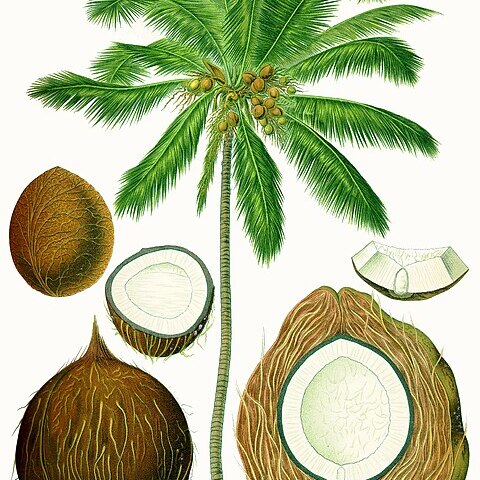Tall, solitary, unarmed, pleonanthic, monoecious tree palm; trunk with leaf-sheaths abscissing cleanly leaving leaf-scars. Leaf-base with continuous reticulate sheath, with a triangular extension opposite the petiole. Leaf pinnate; leaflets regular, reduplicate, entire, single-fold. Inflorescence interfoliar, bisexual, branching to 1 order; prophyll inconspicuous, remaining between the leaf-sheaths; peduncular bract 1, conspicuous, tubular at first, then splitting longitudinally, woody, longitudinally striate, beaked; peduncle moderately long; rachillae spreading, bearing 1–few triads at the base and solitary or paired ♂ flowers distally. Male flowers with 3 imbricate sepals, 3 valvate petals and 6 stamens; pistillode small. Female flowers much larger than the ♂, subglobose, with 3 large imbricate sepals and 3 large imbricate petals; staminodal ring inconspicuous; ovary large, ± spherical, tipped by trifid sessile stigma. Fruit massive, with thick fibrous mesocarp, very hard endocarp with 3 basal pores, and usually only 1 seed; endosperm hard, homogeneous, with central cavity partly filled with liquid; embryo basal. Germination adjacent-ligular; seedling leaf simple.
Solitary tall palms. Stems smooth, with annular leaf scars. Leaves paripinnate, marcescent; leaf sheath clasping, not forming a crownshaft. Pinnae reduplicate, linear-lanceolate, acute or bi-lobed. Inflorescence interfoliar, paniculate, branched to 1 order; bracts 2; prophyll moderate, tubular, persistent, within leaf bases; peduncular bract large, tubular, woody, with longitudinal grooves, attached near prophyll; peduncle short; rachillae stout, at first erect becoming pendulous in fruit. Flowers spirally arranged on rachillae, with triads in proximal portion, paired or solitary staminate flowers in distal portion. Staminate flowers asymmetric; sepals triangular; petals much longer than sepals, thick, leathery; stamens 6; filaments short; anthers medifixed, elongate. Pistillate flower globose, very large; sepals and petals rounded. Fruit very large, ellipsoid to ovoid, 3-angled; stigmatic remains apical; epicarp smooth; mesocarp thick, fibrous; endocarp thick, woody, with 3 basal operculate pores. Seed 1, very large; endosperm homogeneous, with central cavity filled with fluid; embryo basal. Eophyll simple.
Trees with single usually leaning or oblique trunk becoming nude and ringed, feather-leaved, spineless, monoecious: spadices interfoliar, shorter than the leaves, included at first within striate woody but not sulcate or furrowed large cymbas, the inner and longer one of which may persist as a dead object even after the fruit is grown; nodifronds reduced to scale-like bracts 2-4 cm. long that may have more or less-perished by fruiting time: flowers staminate and pistillate, one of the latter normally standing between two of the others near the base of the strand or rachilla but the upper part of the strand staminate and many strands wholly-staminate: fruit a great heavy indehiscent fibrous husk containing 1 hard-shelled nut that bears 3 prominent pores or micropyles at the end opposite the attach-ment to the tree, part of the contents remaining liquid; embryo basal; 3 inner envelopes of the staminate flowers much exceeding the 3 outer ones or calyx and lightly imbricate; envelopes of pistillate flowers very broad, striate, strongly imbricate.
Stems large, solitary, gray, often leaning. Leaves 25-30, pinnate; leaf sheaths open, fibrous; pinnae linear, 1-veined, numerous, regularly arranged along rachis, spreading in same plane. Inflorescences branched to 1 order, borne among leaves, covered by a prophyll and woody, persistent peduncular bract; flowers unisexual, borne in triads at bases of rachillae, male only toward apices. Fruit large, 1-seeded; germination adjacent; eophylls undivided.

